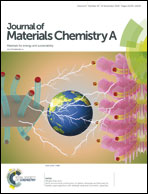Simultaneously improved efficiency and average visible transmittance of semitransparent polymer solar cells with two ultra-narrow bandgap nonfullerene acceptors†
Abstract
One narrow bandgap donor (PTB7-Th) and two ultra-narrow bandgap acceptors (COi8DFIC and IEICO-4F) were elaborately selected to fabricate semitransparent ternary polymer solar cells (PSCs). To find out the optimal content of IEICO-4F in the acceptors, a series of opaque PSCs were first fabricated with 100 nm of Ag as the electrode. The power conversion efficiency (PCE) of the optimized opaque ternary PSCs arrived at 11.94% by incorporating 15 wt% IEICO-4F in the acceptors. Then, the thickness of Ag was adjusted to balance its electrical conductivity and transmittance, and the 100 nm of Ag was replaced by 15 nm of Ag as a semitransparent electrode. The semitransparent electrode possesses high transmittance in the visible light range and low transmittance in the long wavelength range, which is propitious for photon harvesting of ternary active layers with two ultra-narrow bandgap acceptors. The optimized semitransparent ternary PSCs show a synchronously improved PCE of 8.23% and an average visible transmittance (from 370 nm to 740 nm) of 20.78% compared with COi8DFIC based semitransparent binary PSCs. This work suggests the potential of a ternary strategy for fabricating highly efficient semitransparent PSCs with narrow or ultra-narrow bandgap materials as active layers.



 Please wait while we load your content...
Please wait while we load your content...